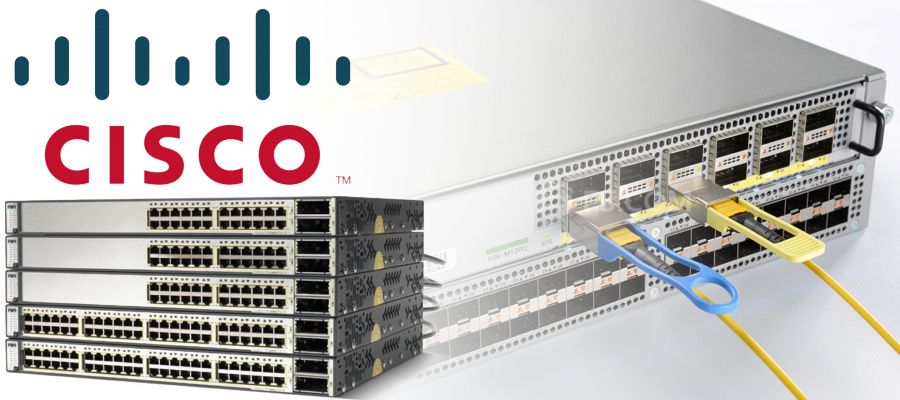Cisco Switches Are One Of The Most Widely Used And Popular Devices Used In Network Equipment and data centers, So Knowing Them Is An Effective Step In Choosing The Right One According To The Changing Needs Of The Organization.
Cisco switches are one of the most widely used and popular devices in network equipment and data centers, so knowing them is a practical step in choosing the right one according to the organization’s changing needs.
Types of switches
Cisco switches are generally divided into two categories:
- Modular switches
- fixed-configuration switches
Cisco modular switches can add modules based on changing organizational needs, such as modules for specific applications, such as firewalls, wireless networks, or network analysis software. At the same time, they also support the possibility of adding interfaces, power supply, and cooling fans.
Therefore, modular switches have higher flexibility and are suitable for developing networks. In terms of price, they are more expensive compared to fixed controls. For example, Cisco Catalyst 3850-X series switches are modular.
Also, getting to know the Cisco WS-C3850-24XU-E switch can provide helpful information in this field.
Fixed configuration switches have a set number of ports and are usually not upgradeable, so they don’t cost much. Fixed switches include unmanaged switches, smart switches, and managed switches. 300/500 series switches are good examples of fixed configuration switches.
Fixed-configuration switches are divided into the following types
1- Managed switches (unmanaged switches)
- Typically, unmanaged switches provide basic connectivity that cannot offer advanced capabilities. These switches do not have an interface to manage and make settings. In other words, they are plug-and-play and are executed after connecting. Unmanaged switches are only fully effective during basic switching. These switches are used in home networks, such as WiFi, or when a few ports are needed, such as in a conference room. Cisco Small Business 110 series switches are examples of this category of switches.
2- Smart switches
- By offering features such as high-quality service, optimal security, and cost-effectiveness, all Smart switches are considered an excellent alternative to modular switches. Of course, these switches are not as flexible as managed switches. Typically, intelligent controls are at the edge of large networks, while managed switches are at the center.
3- Managed switches
- Among fixed-configuration switches, manageable switches are designed to provide the best application experience, the highest level of security, the most accurate monitoring and management of the network, and the highest level of flexibility. As a result, managed switches are usually used as aggregation/access switches in large networks or as core switches in smaller networks.
Manageable switches are the most expensive option among fixed switches and the most popular in large or growing networks.
Other features
Four factors, namely switch speed, number of ports, PoE characteristics, and stackability, should be considered when checking Cisco switches.
- Switch speed: network switches come with different throughput or rates, measured based on the data sent (Mbps). For example, fixed configuration switches can support the following rates:
Fast Ethernet (10/100 Mbps)
Gigabit Ethernet (10/100/1000 Mbps)
Ten Gigabit (10/100/1000/10000 Mbps)
40/100 Gbps (gigabits per second)
Choosing the right speed depends on the required throughput. For example, a Gigabit Ethernet switch like the Cisco WS-C2960X-24PS-L switch is needed to send extensive data regularly and constantly.
- The number of ports: The number of switch ports is also different. The larger the organization and the number of network users, the more ports are needed. For example, fixed configuration switches usually have 5, 8, 10, 16, 24, 48, and 52 ports.
PoE or non-PoE: PoE capability makes it possible to supply power to devices such as iPhones, surveillance cameras, or wireless access points through a cable to transmit traffic. The advantage of this method is that the endpoints can be placed anywhere, even in areas where it is challenging to provide separate electricity infrastructure. In general, switches with PoE are expensive.
- stackable standalone
Standalone switches are configured and managed individually and also have limited capacity. But their advantage is that they are straightforward to troubleshoot if a problem occurs.
Stackable switches are switches that can be connected or stacked to increase capacity. The stack is considered a single unit to configure, manage, and troubleshoot each switch. In other words, the network continues to function as problems occur in any part of the stack.
Classification of Cisco switches based on the three-layer model
Based on the hierarchical division that plays a role in the LAN environment, Cisco switches include the following three categories:
- Access layer: This layer allows end devices to access the network in the LAN environment; remote access is also permitted in the WAN environment. Considering that these switches are designed for end users. These switches are usually Gigabit Ethernet.
- Distribution layer: This layer is the second layer of hierarchical categories. The switches that are connected to this layer are known as distribution switches. Unlike access layer switches, they do not have end-device services. The intelligent distribution layer manages routing, filtering, and quality of service policies. The switches of this layer receive traffic from the access layer and direct it to the core layer.
- Core layer: This layer is considered the main foundation of the network and makes it possible to establish a connection between distribution layer devices at a very high speed. The core layer is the endpoint of data collection, so it must have a high capacity and fault tolerance.
FAQ
What security features do Cisco switches provide?
Cisco switches offer DHCP snooping, IP Source Guard, Dynamic ARP Inspection, 802.1X port authentication, and MAC/IP-based ACLs to protect networks.
How does Dynamic ARP Inspection improve network safety?
It validates ARP packets against a trusted database, preventing man-in-the-middle attacks and IP/MAC spoofing.
It validates ARP packets against a trusted database, preventing man-in-the-middle attacks and IP/MAC spoofing.
Yes — 802.1X authentication and MAC-based ACLs allow only authorized devices and users to connect.

